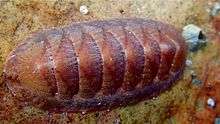Callochiton dentatus
Callochiton dentatus, the broad chiton, is a medium to large-sized polyplacophoran mollusc in the family Callochitonidae,[1] found on the coast of southern Africa.
| Callochiton dentatus | |
|---|---|
 | |
| Scientific classification | |
| Kingdom: | |
| Phylum: | |
| Class: | |
| Order: | |
| Family: | Callochitonidae |
| Genus: | |
| Species: | C. dentatus |
| Binomial name | |
| Callochiton dentatus Spengler, 1797 | |
| Synonyms | |
| |
Description
This is a very flat and broad chiton with valves that are dark brown to orange, shiny and finely granulated. The wide girdle is densely covered with very small, elongate scales that produce a velvet-like texture. The margin of each valve contains a diagnostic slit that is visible if the girdle is pulled away. The species reaches a size of 20–50 mm.[2]
Distribution and habitat
C. dentatus occurs along the south coast of Africa, from Cape Columbine in Namibia to the south coast of KwaZulu-Natal in South Africa. It is uncommon and can usually be found as solitary individuals under rocks near the low tide mark.[2] The original description by Lorenz Spengler recorded it at the Cape of Good Hope.[3]
References
- E. Schwabe (2015). "Chiton politus". WoRMS. World Register of Marine Species. Retrieved 28 December 2016.
- Branch, G. M.; Griffiths, C. L.; Branch, M. L.; Beckley, L. E. (2010). Two Oceans: a Guide to the Marine Life of Southern Africa. Cape Town: Struik Nature.
- Spengler, L. (1790). "Beskrivelse og Oplysning over den hindindtil lidet udarbeidede Sloegt af mangeskallede Konchylier som Linnaeus har kaldet Lepas med tilfoiede nye og ubeskrevne Arter". Skrivter af Naturhistorie-Selskabet. 1 (1): 158–212.